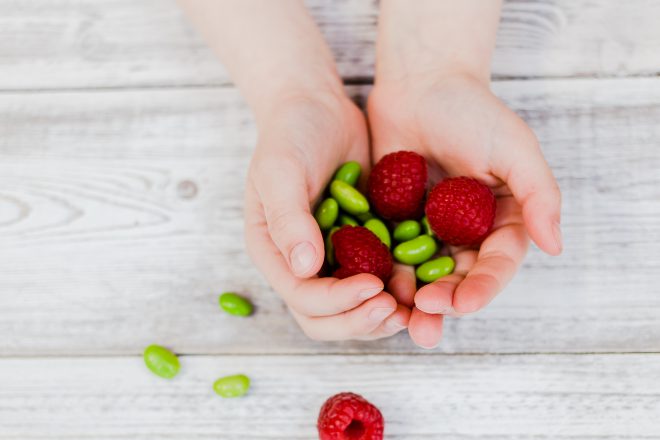As adults our attitude to snacking is rapidly changing – the on-the-go market is worth millions and new products continue to hit the shelves and challenge our thinking on what a snack should be.
Not surprisingly the children’s snack market is following suit – but what is marketed as a snack for children doesn’t necessarily make a good one. Ideally snacks should provide us with an opportunity to top up on vitamins and minerals, especially as sometimes mealtimes can be a bit hit and miss (unless you’ve attended one of Sarah’s workshops of course 😉)!
So, what makes a good snack for children and how do we make sure we raise children with the right attitudes to snacking? Here are my top tips!
When to snack
Children benefit from 1 – 2 snacks a day, between meals. It’s useful to leave at least an hour and a half between snacks and meals though so as not to influence their appetite. Fussy eating is often magnified if they’re simply not hungry.
Fresh fruit is an ideal snack and always my preference for a morning snack as there is usually less time between breakfast and lunch and it fills the gap nicely. Packed full of fibre and vitamins, it’s a really good habit to normalise in childhood so that they can carry it on into adulthood. Habits that we learn in childhood and repeat daily tend to set the benchmark for later in life. Take brushing our teeth for example, simple repetition of this important healthy behaviour ensures we continue it throughout our life. It would be great to think we could have the same influence over our children’s fruit intake!
What else makes a good snack for children?
Children have high energy requirements to support their rapid growth. Carbohydrates are the energy givers and additional carbohydrate in snacks is important to top up their needs. Personal favourites are oat cakes, corn crackers and whole-wheat breadsticks.
Carb snacks with a little more sweetness also work well, for example, malt loaf, mini pancakes, brioche are also good options. They provide around a tsp sugar which is not a bad trade-off in my book for a snack which is well liked and also goes well with cut up fresh fruit, for example, peaches or strawberries.
Ideal snacks to keep them fuller a bit longer
Protein is a nutrient known for helping us to feel full – combining protein and carbohydrate together is the perfect way to regulate blood sugar levels and keep hunger at bay. If the carbohydrate also provides some fibre that’s a bonus.
If your children are over five, nuts are great. Dietitian’s favourites include unsalted peanuts, walnuts, almonds and cashew nuts.
Hummus is a good dipper for veggie sticks. I particularly like the beetroot variety I found recently. Hummus hasn’t got that much protein in it because of the oil to chickpea ratio but it’s a good accompaniment to boost veg and fibre intakes. Homemade varieties will contain less salt and serving it in an egg cup is the perfect portion size.
Cheese portions are great – a calcium boost alongside a protein portion. Despite the level of processing the string types are no different nutritionally to something like a Babybel. Salt is something to watch with cheese but in these pre-determined portion sizes the salt doesn’t contribute too much to the diet.
However, edamame beans are a personal favourite of mine – quick to defrost and packed full of protein and fibre.
Navigating the children’s snack aisle
Where possible it’s ideal to keep snacks looking like ‘real’ food that children can identify with. If we start to make each snack a child friendly replica of a less than healthy adult snack e.g. ‘a cheese puff’ then we are teaching them snacks are completely different to normal foods, which isn’t ideal for their long-term attitude to healthy eating.
The truth behind the 1 of your 5 a day claim
Fresh fruit can obviously make the 5 a day claim but the on-the-go snack market is a little less clear with many products claiming to provide a portion of fruit or veg. In adults a portion is classed as 80g but there is no official guidance for children although it is often taken to be 40g.
Many dried fruit snacks will have been heated to high temperatures and had stabilisers and gumming agents added to them to make them into certain shapes, so it’s a good idea to check the label behind the claims and choose brands that are only made from whole fruit and veg and nothing else.
Another one to watch is yoghurt coated fruit – we think of yoghurt as healthy but when it’s a coating, it really is nothing like yoghurt, it’s just sugar.
The supermarket can feel a tricky place to navigate especially when catering for the whole family who may have different needs. For more nutrition advice or information please get in touch with me or check out my blog and social media posts supporting people to #eatitreal.
